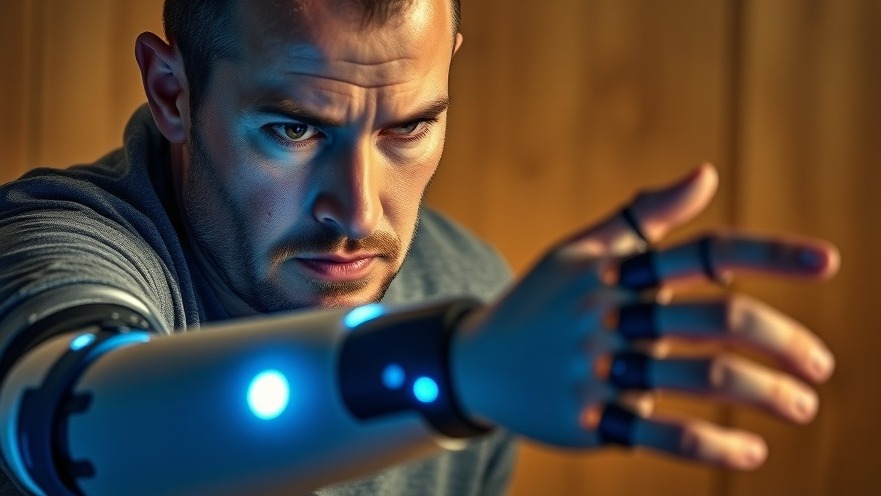
Revolutionizing Mobility: How Thought-Controlled Robots Are Changing Lives
Imagine a world where paralyzed individuals can regain some autonomy simply by thinking about movement. Researchers at the University of California, San Francisco have achieved a groundbreaking milestone in this vision by developing a brain-computer interface (BCI) that allows a man paralyzed by stroke to control a robotic arm using only his thoughts. This remarkable development not only enhances our understanding of neurology but also opens up new frontiers for rehabilitation and patient care.
Unlocking the Power of Imagination
In a recent study published in Cell, it was revealed that the subject could grasp, move, and drop objects through mere imagination of those actions. This unprecedented technology allows for seamless communication between the brain and machines by interpreting neural signals and translating them into actionable movements. This user's ability to control the robotic arm persisted for an astounding seven months without requiring recalibration, a substantial improvement over previous BCI systems which typically failed after just a day or two.
The AI Revolution in Brain-Computer Interfaces
The BCI leverages advanced artificial intelligence to learn and adapt to the brain's dynamic signals. According to Dr. Karunesh Ganguly, a neurology professor involved in the study, “The blending of learning between humans and AI is the next phase for these brain-computer interfaces. It's what we need to achieve sophisticated, lifelike functions.” By accounting for the small but notable shifts in brain activity as the participant imagined specific movements, the AI enhanced the BCI’s effectiveness over time. This interaction between human cognition and technology could lead to groundbreaking applications in daily life.
Bridging the Gap Between Thought and Action
Before using the robotic arm, the participant underwent training with a virtual robot arm. This exercise enabled him to refine his mental visualizations, thereby improving accuracy and enhancing his ability to control the physical arm. Such preparation is critical; as with any skill, practice is needed to foster fluency in this unique form of interface control. By the end of the process, he was able to open a cabinet, retrieve a cup, and even pour himself a drink.
Long-Term Implications for Rehabilitation
This technology heralds a new era in rehabilitation for patients with limited mobility. The ability to perform simple tasks independently can significantly enhance a person's quality of life. As technology advances, we foresee greater integration of BCIs into therapeutic practices, allowing individuals with paralysis to engage more fully in their daily activities. Dr. Ganguly is currently exploring ways to refine AI models, increasing both speed and fluidity of movement, and is eager to test these devices in non-clinical environments.
The Future Is Here: A Look at Noninvasive Solutions
While this study demonstrates remarkable progress, it comes amidst an evolving field of BCIs. At Carnegie Mellon University, researchers are also exploring noninvasive methods to control robotic devices using thoughts. They aim to achieve similar capabilities without the complexities and risks associated with implanted sensors. This comparative analysis of invasive versus noninvasive approaches provides a broader understanding of the challenges and opportunities in neurotechnological research.
Challenges and Considerations in BCI Development
Despite the impressive advancements, there are challenges to address. Noninvasive BCIs, while promising, face obstacles related to signal clarity and precision. Improving the resolution of neural signals captured noninvasively remains a key hurdle. However, the momentum gained from recent successes gives hope that future iterations of this technology will be both effective and universally accessible, potentially benefiting millions of patients worldwide.
Emotional Impact: Why This Matters to Patients and Practitioners
For healthcare practitioners focused on patient outcomes, understanding and implementing BCI technology is crucial. The profound emotional impact of regaining independence cannot be understated. BCIs have potential applications that extend beyond mere functionality; they can restore a sense of agency and identity to patients who may have lost hope after significant medical events. As practitioners, staying ahead of these technological advancements enables better preparedness to support affected patients in their recovery journeys.
In conclusion, the implications of this research extend beyond individual patient outcomes. As more advancements in BCI technology develop and become integrated into rehabilitation practices, the entire landscape of neuromedical care will shift. By embracing these innovations, healthcare practitioners can lead the charge in enhancing life quality for paralyzed individuals everywhere.
If you are eager to learn more about how BCI technology can transform patient care and improve autonomy for those with paralysis, connect with your medical networks today and share the potential impact of these emerging technologies.
 Add Row
Add Row  Add
Add 






Write A Comment